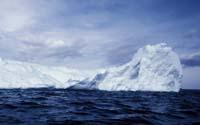Uncertainty in the fate of polar ice

A deep study in Antarctica confirms that the South Pole ice sheet is shrinking. In 2006 alone, it lost 200 billion tons of ice, 75% more than in 1996.
However, the only problem is not that the ice melts; if it snowed as much as the melting ice there would be no problem. But it is not so, that is, more ice is melting than snow accumulates.
Climate experts discuss the influence of Earth warming on the world's two largest ice sheets, Greenland and Antarctica. In fact, global warming can cause an increase in the precipitation rate in certain areas and, if this occurs at the poles, an increase in ice sheets can occur. A study on ice accumulation in eastern Antarctica was published in 2005.
It seems to have happened before. In a period of heat on Earth about 91 million years ago, greenhouse gases were 3 to 10 times more abundant than now. And under these conditions a large layer of ice was formed in Antarctica, as they have deduced from the traces of the time.
Current weather forecasts do not determine whether polar ice will melt completely or whether the ice sheet will increase. However, what most worries researchers are the ice sheets of western Antarctica and Greenland, the smallest and most vulnerable.





